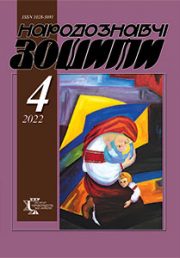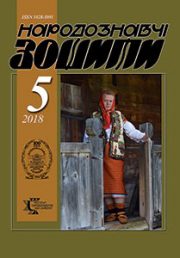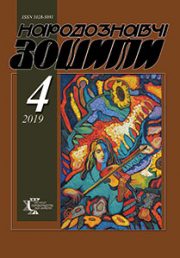The Ethnology Notebooks. 2021. № 6 (162), 1457—1467
UDK 930.2:94(477.83/.86=512.1)”191/193″
DOI https://doi.org/10.15407/nz2021.06.1457
KARAITES IN CULTURAL MOSAIC OF INTERWAR GALICIA (According to the journal «Myśl karaimska»)
CHORNIY Petro
- ORCID ID: https://orcid.org/0000-0002-4521-9597
- PhD in History, Research Fellow,
- Department of Social Anthropology,
- Institute of Ethnology, National Academy of Sciences of Ukraine,
- 15, Svobody Avenue, 79000, Lviv, Ukraine,
- Contacts: e-mail: p.chorniy@gmail.com
Abstract. The problem of origin and existence of Karaites was investigated in the article with a focus on the interwar period. The main theories of the origin of this ethnoreligious community were given and analyzed and also presented the author’s understanding of Karaite ethnogenesis appealing to the context of Galicia.
Over the centuries Karaite communities have undergone constant socio-cultural transformations under the influence of cultures and religions among which they lived. However, Karaites managed to consistently adhere to their own biblical ethos presenting its religious tradition as a real, unaltered or supplemented orthodox form of Jewish civilization. The purpose of the research is to find out who Karaites are, when and under what conditions they came to Galicia; how Karaites managed to preserve their identity and separateness for many centuries; to learn the peculiarities of the public governance of Galician Karaite religious community during the 1920s and 1930s, their traditions and practices of network communication and institutional management within Galicia and interwar Poland in general.
Research methods. While writing the scientific article the research dialectical principle of learning and evaluating objects and phenomena in their historical development (the principle of historism) was used. To verify involved information a comparative method was used, content-analysis and discourse-analysis were performed. In the process of combining and reconciling archival materials and historiographical information the method of complex analysis was applied.
The source basis of the research is the materials of the journal «Myśl karaimska» — a leading intellectual platform where humanitarians presented their Karaims studios — historical, ethnographic, linguistic, religious, anthropological and cultural studies as well as chronicles of the most important events from life of the Karaite communities in interwar Poland, including Galicia. Due to the fact that this journal has not been available to Ukrainian researchers for many decades most of the information contained in its pages has not previously been used in major studies which determines relevance and novelty of this research. After all it allowed a new look at the old research questions as well as to identify new research tasks.
Keywords: Karaites, Karaism, Myśl karaimska, Galicia, interwar period, Gaham, Karaite religious union.
Received 7.09.2021
REFERENCES
- Moroz, V. Karaites of Halych — history and heritage of a forgotten community. RISU. Retrieved from: https://risu.org.ua/ua/index/studios/studies_of_religions/61804/ (Last accessed: 5.02.2017) [in Ukrainian].
- Arabadzhy, A. (2002). The history of the emergence of the Karaite community in Halych. The Halych Karaims: history and culture: materials of international conference (Halych, 6—9 of September 2002) (Pp. 89—93). Lviv; Halych: Spolom [in Russian].
- Bakaliarchyk, M. (2002). The origin of the Karaites (in the light of anthropological research 30—70 years of the twentieth century). The Halych Karaims: history and culture: materials of international conference (Halych, 6—9 of September 2002) (Pp. 156—158). Lviv; Halych: Spolom [in Ukrainian].
- Diachenko, V. (1965). Anthropological composition of the Ukrainian people: a comparative study of the peoples of the USSR and adjacent territories. Kyiv: Naukova dumka [in Ukrainian].
- Pushyk, S. (2002). Karaite poet Zakharia Samuilovych Abrahamovych. The Halych Karaims: history and culture: materials of international conference, (Halych, 6—9 of September 2002) (Pp. 113—124). Lviv; Halych: Spolom [in Ukrainian].
- Czekanowski, J. (1967). Man in time and space. Warsaw [in Polish].
- Halevi (Kirchuk), P.-I. (2012). Hebrew. The Oxford Handbook of Jewish Studies (Vol. 1, pp. 529—554). Kyiv: Dukh i Litera; Dnipropetrovsk: Centre «Tkuma» [in Ukrainian].
- (1942). Karaites. Ukrainian word, 31 (72), 5 [in Ukrainian].
- Dashkevych, Ya. (1996). Karaites. Ethnic directory. Ethnic minorities in Ukraine (Part 2, pp. 61—62). Kyiv [in Ukrainian].
- Steinlauf, M.C. (1989). Mark Arnshteyn and Polish-Jewish Theater. The Jews of Poland between Two World Wars (Pp. 399—411). Hanover, NH: Published for Brandeis University Press by University Press of New England.
- (1925). Something about the people’s «self-closure». Dilo, 160—162, 1; 2—3 [in Ukrainian].
- Poliak, M. (2012). Medieval Karaite. The Oxford Handbook of Jewish Studies (Vol. 1, pp. 320—353). Kyiv: Dukh i Litera; Dnipropetrovsk: Centre «Tkuma» [in Ukrainian].
- Yaroshinskaia, I. (2002). Karaims — age-old feature of the city of Halych and Europe. The Halych Karaims: history and culture: materials of international conference (Halych, 6—9 of September 2002) (Pp. 101—107). Lviv; Halych: Spolom [in Russian].
- Tyloch, W. (1987). Judaism. Warsaw: National Publishing Agency [in Polish].
- Ta-Shma, I. (2012). Rabbinic literature of the Middle Ages (1000—1492). The Oxford Handbook of Jewish Studies (Vol. 1, pp. 242—263). Kyiv: Dukh i Litera; Dnipropetrovsk: Centre «Tkuma» [in Ukrainian].
- Vikhnovich, V.L. (1997). Karaite Abraham Firkovich: Jewish Manuscripts. History. Trips. Saint Petersburg [in Russian].
- Kizilov, M. (2009). The Karaites of Galicia. An Ethnoreligious Minority among the Ashkenazim, the Turks and the Slavs 1772—1945. Leiden; Boston: Brill.
- Zarachowicz, Z. (1924). A few comments about our tasks at the moment. Karaim thought, 1, 5—6 [in Polish].
- (1913). From the life of non-state nations. Rada, 174, 2 [in Ukrainian].
- (1913). For the election of Hakham. Chronicle of current life. Karaite word, 2, 17 [in Russian].
- Zaitsev, I., & Kizilov, M. (2013). Travel of Seraya Shapshal across Turkey in 1911. Eastern Archive, 1 (27), 25—34 [in Russian].
- Yeshvovych, Ya. (2002). Galician Karaite community in the twentieth century. The Halych Karaims: history and culture: materials of international conference (Halych, 6—9 of September 2002) (Pp. 4—10). Lviv; Halych: Spolom [in Ukrainian]
- Janusz, B. (1927). Karaites in Poland. Krakow: Published by the Geographical Bookstore «Orbis» (Geographical library «Orbis». Series III (Vol. 11: Poland, land and man) [in Polish].
- Yurchenko, I. (2002). Study of the Karaite cemetery near Halych. The Halych Karaims: history and culture: materials of international conference (Halych, 6—9 of September 2002) (Pp. 46—56). Lviv; Halych: Spolom [in Ukrainian].
- Yurchenko, I. (2000). Karaite cemetery near Halych. Catalog of tombstones. Lviv; Halych: Spolom [in Ukrainian].
- Piletski, Sh. (2002). The Role of the Karaites of Halych in Establishing the Legal Status of the Karaite Communities in 1920—30. The Halych Karaims: history and culture: materials of international conference (Halych, 6—9 of September 2002) (Pp. 94—100). Lviv; Halych: Spolom [in Russian].
- (1924). On the Karaim attitude towards the Government, the organization of the clerical Karaim authorities and the internal system of Karaim communes. Karaim thought, 1, 7—8 [in Polish].
- Zarachowicz, Z. (1924). Letters from Halych. Karaim thought, 1, 27—28 [in Polish].
- Vasylchuk, N. The Karaite community of Halych is 770 years old. Museum space. Retrieved from: http://prostir.museum/ua/post/38511 (Last accessed: 5.02.2017) [in Ukrainian].
- (1935—1936). From the life of Karaims in Poland. Karaim thought, 2, 118—119 [in Polish].
- Dashkevych, Ya. (2002). Migration of Karaites to Rus’-Ukraine and Lithuania (IX—XIV centuries). The Halych Karaims: history and culture: materials of international conference (appendix) (Halych, 6—9 of September 2002) (Pp. 165—193). Lviv; Halych: Spolom [in Ukrainian].
- (1924). From the editorial office. Karaim thought, 1, 2 [in Polish].
- (1924). «Karaites in Poland». (About Dr. M. Baіaban’s article). Karaim thought, 1, 3—4 [in Polish].
- (1924). Privileges granted to Karaites by the Polish kings. Karaim thought, 1, 22 [in Polish].
- Dobosh, H. Galician Karaites: there are only two left. Firtka.if.ua. News agency. Retrieved from: http://www.firtka.if.ua/blog/view/galicki-karaimi-lisilos-tilki-dvoe119578 (Last accessed: 5.02.2017) [in Ukrainian].






